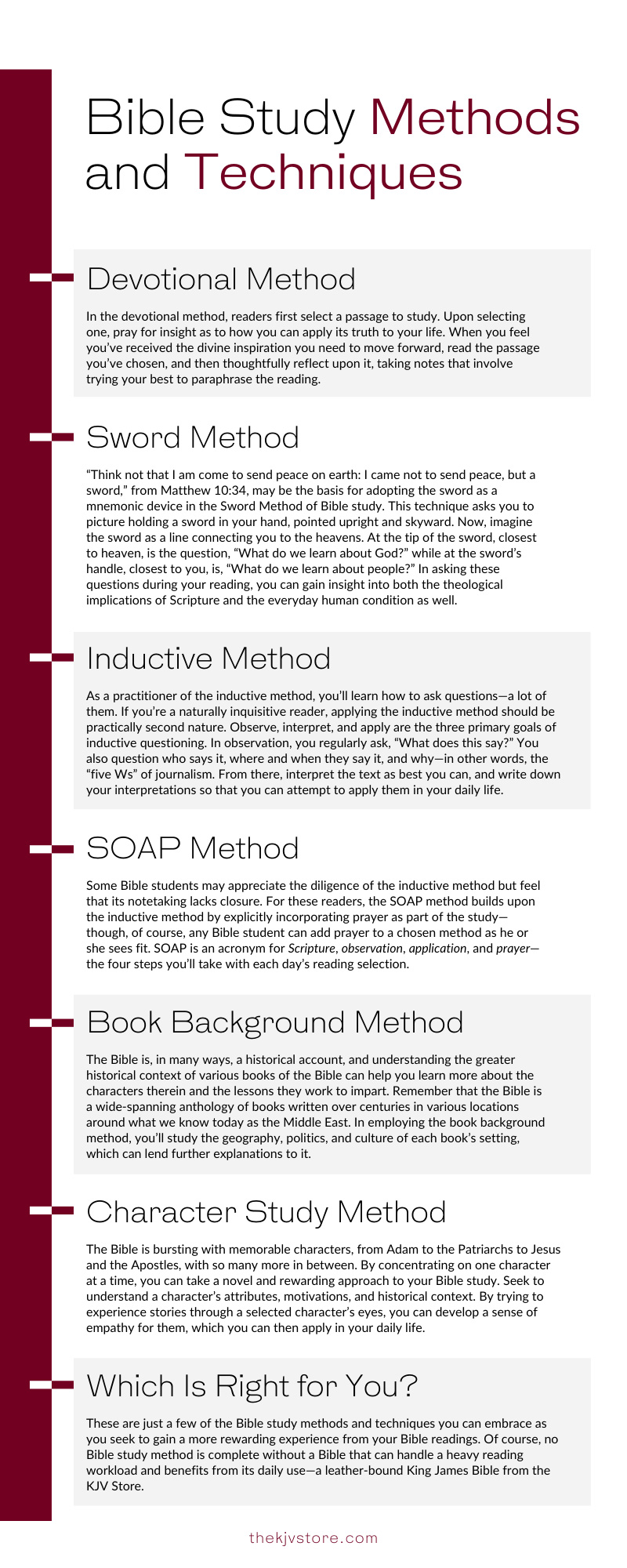Bible Study Methods and Techniques

One of the biggest challenges new Christians (and even long-practicing Christians) face is making their Bible study more engaging and constructive. It can be frustrating to complete a daily Bible devotional yet feel that we’ve absorbed nothing from the reading selection—simply turning the pages as if it were some middlebrow potboiler. This is no way to approach Scripture, of course. While you may be proud of having an elegant and beautiful King James Bible on hand, its elegance does little good if you don’t employ a thoughtful reading strategy. Fortunately, there are many such approaches a reader can take to gain a deeper understanding of the Bible, chapter by chapter and book by book, ranging from freeform explorations of the text to more structured plans that require additional resources. To get the most out of your Bible, consider approaching it with one of these Bible study methods and techniques.
Devotional Method
The devotional method of Bible study is a simple approach that represents an ideal technique for new Christians or busy students who don’t have the time or energy necessary for more involved strategies. In the devotional method, readers first select a passage to study. Upon selecting one, pray for insight as to how you can apply its truth to your life. When you feel you’ve received the divine inspiration you need to move forward, read the passage you’ve chosen, and then thoughtfully reflect upon it, taking notes that involve trying your best to paraphrase the reading. This technique is especially helpful when reading the King James Bible, which uses prose that, although beautiful, doesn't always resemble contemporary English. After completing your prayer, reading, and note-taking, try to commit a particularly relevant verse from your reading selection to memory.
Sword Method
“Think not that I am come to send peace on earth: I came not to send peace, but a sword,” from Matthew 10:34, may be the basis for adopting the sword as a mnemonic device in the Sword Method of Bible study. This technique asks you to picture holding a sword in your hand, pointed upright and skyward. Now, imagine the sword as a line connecting you to the heavens. This diagram is useful for the questions you should ask following each reading selection. Along the two edges of the blade are four questions: “Is there a sin to avoid?” and, “Is there a promise to believe?” along the left and, “Is there an example to follow?” and, “Is there a command to obey?” along the right. At the tip of the sword, closest to heaven, is the question, “What do we learn about God?” while at the sword’s handle, closest to you, is, “What do we learn about people?” In asking these questions during your reading, you can gain insight into both the theological implications of Scripture and the everyday human condition as well.
Inductive Method
As a practitioner of the inductive method, you’ll learn how to ask questions—a lot of them. If you’re a naturally inquisitive reader, applying the inductive method should be practically second nature. Observe, interpret, and apply are the three primary goals of inductive questioning. In observation, you regularly ask, “What does this say?” You also question who says it, where and when they say it, and why—in other words, the “five Ws” of journalism. From there, interpret the text as best you can, and write down your interpretations so that you can attempt to apply them in your daily life.
SOAP Method
Some Bible students may appreciate the diligence of the inductive method but feel that its notetaking lacks closure. For these readers, the SOAP method builds upon the inductive method by explicitly incorporating prayer as part of the study—though, of course, any Bible student can add prayer to a chosen method as he or she sees fit. SOAP is an acronym for Scripture, observation, application, and prayer—the four steps you’ll take with each day’s reading selection. After completing your Scripture reading, progress to making observations using the same questions you would ask in the inductive method. Following this, consider how you can apply these lessons, culminating in a prayer thanking the Lord for His guidance through your studies.
Book Background Method
The Bible is, in many ways, a historical account, and understanding the greater historical context of various books of the Bible can help you learn more about the characters therein and the lessons they work to impart. Remember that the Bible is a wide-spanning anthology of books written over centuries in various locations around what we know today as the Middle East. In employing the book background method, you’ll study the geography, politics, and culture of each book’s setting, which can lend further explanations to it. A reference Bible can help you in this respect, but to truly explore the background of each book of the Bible, you may need numerous other history books to supplement your reading. While this can be a most rewarding course of study, it’s not practical for people who are short on time or don’t have the patience for the deep dives that make up the method.
Character Study Method
The Bible is bursting with memorable characters, from Adam to the Patriarchs to Jesus and the Apostles, with so many more in between. By concentrating on one character at a time, you can take a novel and rewarding approach to your Bible study. Seek to understand a character’s attributes, motivations, and historical context. By trying to experience stories through a selected character’s eyes, you can develop a sense of empathy for them, which you can then apply in your daily life.
Which Is Right for You?
These are just a few of the Bible study methods and techniques you can embrace as you seek to gain a more rewarding experience from your Bible readings. Of course, no Bible study method is complete without a Bible that can handle a heavy reading workload and benefits from its daily use—a leather-bound King James Bible from the KJV Store. Whichever technique you choose, make a leather KJV Bible the basis of your daily reading.

